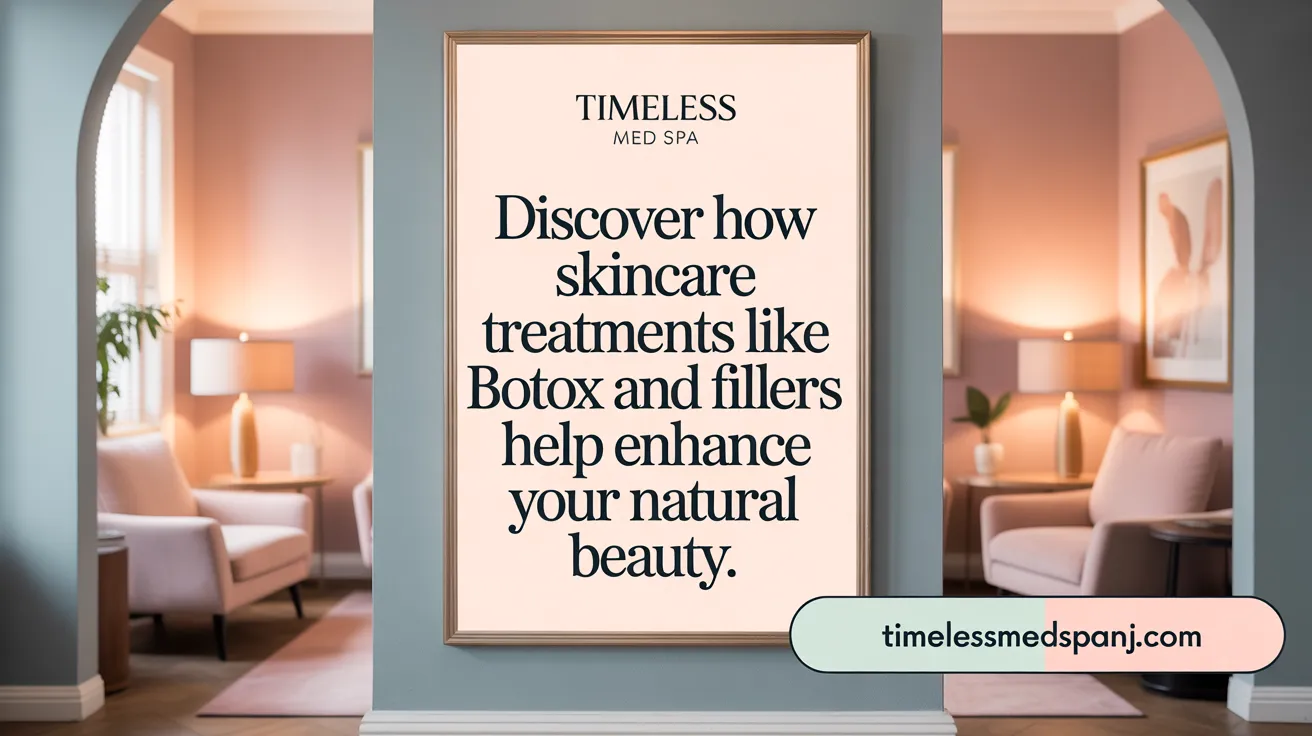Decoding the Basics of Botox and Fillers
As non-surgical cosmetic treatments gain popularity, Botox and dermal fillers have emerged as frontrunners in facial rejuvenation. While they share the common goal of reducing signs of aging, their mechanisms and applications differ fundamentally. This guide unpacks these differences to help you decide which treatment aligns with your aesthetic goals.
Fundamental Differences Between Botox and Dermal Fillers
What are the fundamental differences between Botox and dermal fillers?
Botox and dermal fillers are popular cosmetic treatments, but they work in very different ways and are used for different concerns.
Botox is a neurotoxin made from bacteria, specifically botulinum toxin. It works by blocking nerve signals to the muscles, causing them to relax temporarily. This relaxation reduces the appearance of dynamic wrinkles—those caused by repeated facial movements—such as frown lines, crow’s feet, and forehead lines. The effects of Botox usually last around 3 to 4 months and are most effective on areas where muscle movement causes wrinkles.
Dermal fillers, on the other hand, are gel-like substances injected beneath the skin to restore lost volume, fill static wrinkles (visible even at rest), and improve facial contours. Many fillers are made of hyaluronic acid, a natural substance found in the body that helps skin stay plump and firm. Fillers work immediately upon injection, providing instant improvements that can last from six months to two years, depending on the product and treated area.
In terms of application, Botox targets muscle activity, essentially softening expression lines by preventing muscles from contracting. Fillers add fullness, reshape features, and smooth out static lines and folds that are a result of aging and volume depletion.
Both treatments can be combined to achieve comprehensive facial rejuvenation, addressing both dynamic and static signs of aging. While Botox is generally more affordable and produces temporary results, fillers offer longer-lasting effects and are used to restore volume and contour.
Risks and side effects differ slightly, with Botox potentially causing temporary muscle weakness or eyelid drooping, and fillers risking lumps, swelling, or, in rare cases, blood vessel occlusion.
Choosing between them depends on the specific concerns—whether it’s reducing muscle-induced wrinkles or restoring facial volume. When performed by trained professionals, both procedures are considered safe and effective.
How Botox and Dermal Fillers Work to Enhance Your Appearance

How do Botox and dermal fillers work?
Botox functions by injecting a purified form of botulinum toxin into specific facial muscles. This neurotoxin temporarily blocks nerve signals that stimulate muscle contractions. As a result, the targeted muscles relax, softening the appearance of dynamic wrinkles caused by repetitive movements, such as frown lines, crow’s feet, and forehead lines.
The effects of Botox usually become noticeable within a few days to two weeks after treatment. The relaxing of muscles results in a smoother, more youthful look, but the effects are temporary, typically lasting about 3 to 6 months. Regular treatments are necessary to maintain the results.
Dermal fillers, on the other hand, are gel-like substances injected beneath the skin, primarily made of hyaluronic acid — a natural compound found in the body that attracts water to hydrate and plump the skin. Fillers are used to add volume, support, and contour to areas such as cheeks, lips, and around the mouth.
Unlike Botox, fillers provide immediate results. As soon as the injection is completed, patients can see improvements, with the effects lasting anywhere from 6 months to 2 years depending on the type of filler used and the area treated.
Both treatments are minimally invasive and performed by trained healthcare professionals. While Botox is mainly used to reduce fine lines caused by muscle activity, fillers aim to restore lost volume, diminish static wrinkles, and improve facial contours. Combining both can provide comprehensive facial rejuvenation, smoothing wrinkles and enhancing volume for a more natural, youthful appearance.
Typical Uses: Targeting Wrinkles and Facial Volume

What are the typical uses and purposes of Botox compared to dermal fillers?
Botox and dermal fillers serve distinct yet complementary roles in facial rejuvenation. Botox is mainly employed to address dynamic wrinkles—those caused by muscle movements—by relaxing the muscles responsible for lines and creases. Common areas treated with Botox include the forehead, between the eyebrows (glabella), around the eyes (crow’s feet), and bunny lines on the nose.
In contrast, dermal fillers are used to restore facial volume, fill static wrinkles, and enhance contours. They are injected into areas like the cheeks, lips, under-eye hollows, jawline, and chin to add support and structure.
Botox works by temporarily paralyzing muscle activity, smoothing out expression lines that appear when muscles contract repeatedly over time. Usually lasting three to four months, the effects involve a temporary reduction in muscle movement.
Fillers, typically made from hyaluronic acid or other substances, provide immediate volume and correction. They can last from six months up to two years depending on the specific product and treatment site. While Botox is ideal for smoothing expression lines, fillers are better suited for restoring lost volume, diminishing deep folds, and shaping facial features.
Many patients choose a combination of both treatments to achieve a balanced, youthful appearance. This dual approach addresses both static and dynamic signs of aging, offering a comprehensive rejuvenation tailored to individual needs.
Visible Effects and Duration of Botox vs Fillers

What are the effects and visible results of each treatment?
Botox generally produces a softer, more relaxed appearance by reducing muscle activity that causes expression lines. Patients usually see visible results within about two weeks after treatment, with effects lasting approximately three to four months. It is particularly effective in diminishing dynamic wrinkles like frown lines, crow’s feet, and forehead lines by temporarily paralyzing the muscles involved. In contrast, dermal fillers offer immediate transformation. The results are visible right after the injection session, restoring lost volume and filling in static wrinkles such as those around the mouth, in cheeks, or under eyes. Fillers can enhance facial contours, plump lips, and diminish signs of aging, providing a more youthful look. The effects can last anywhere from six months to two years, depending on the type of filler used. Both procedures lead to noticeable improvements, but Botox mainly relaxes muscles to reduce wrinkle formation, while fillers add volume and structure.
How long do the effects of Botox and dermal fillers typically last?
The longevity of results varies between Botox and fillers. Botox's effects are temporary, usually lasting about 3 to 4 months. Patients begin to notice improvements within 3 to 7 days, with full effects emerging around two weeks post-treatment. To sustain the smooth, wrinkle-free look, regular treatments every three to five months are recommended. Fillers tend to last longer, with effects generally lasting between 6 and 12 months. Some types, such as Poly-L-lactic acid (PLLA), can maintain results for up to two years, whereas other formulations like hyaluronic acid typically last six to twelve months. The duration depends on the specific product, the area treated, and individual factors such as lifestyle and skin characteristics. Both treatments are minimally invasive, performed through injections by trained healthcare providers. The period of maintaining the aesthetic results may vary based on personal aging processes and treatment frequency.
Safety, Side Effects, and Risk Considerations
What are the side effects, risks, and safety considerations associated with Botox and dermal fillers?
Botox and dermal fillers are popular cosmetic treatments known for their effectiveness and minimal invasiveness. When administered by qualified, experienced professionals, both procedures are generally considered safe. However, like all medical treatments, they carry potential risks and side effects.
Common side effects of Botox include bruising, swelling, pain, and redness at the injection sites. These reactions are usually temporary and resolve within a few days. Less frequently, Botox may cause muscle weakness, neck pain, headache, or eyelid drooping, especially if the toxin spreads beyond the targeted area. Serious but rare risks include difficulty swallowing or breathing, which require immediate medical attention.
Dermal fillers can cause similar minor reactions such as swelling, bruising, or redness. Additionally, some individuals might develop pimple-like eruptions, asymmetry, or skin discoloration temporarily. Rare but serious complications involve allergic reactions, skin necrosis (death of skin tissue) if a blood vessel is inadvertently blocked, or infection at the injection site.
Ensuring safety involves choosing a reputable, licensed, and experienced medical provider. Proper technique minimizes the likelihood of nerve or blood vessel injury. Both treatments should be avoided by pregnant or nursing women and persons with neuro-muscular disorders, such as myasthenia gravis or Lambert-Eaton syndrome, which could worsen symptoms.
Pre-treatment consultation is crucial. An experienced professional assesses individual health history, facial anatomy, and specific concerns. Adherence to recommended post-treatment care and follow-up helps prevent complications and ensures satisfactory results.
In summary, although Botox and fillers are safe for most recipients, awareness of potential side effects and risks, combined with professional administration, is essential to maintain safety and achieve natural-looking, effective outcomes.
Choosing the Right Treatment for Your Aesthetic Goals

Which treatment is suitable for specific aesthetic concerns or goals?
The best choice between Botox and dermal fillers hinges on your individual aesthetic objectives and the specific characteristics of your facial aging. Botox is particularly effective for softening dynamic wrinkles—those caused by muscle movements—such as crow’s feet, frown lines, and forehead lines. It temporarily relaxes these muscles, leading to smoother skin, with results lasting about 3-4 months.
Dermal fillers, on the other hand, are ideal for restoring volume, filling static wrinkles—those visible even when the face is at rest—and enhancing facial features like lips and cheek contours. Depending on the type of filler used, effects can last from several months to several years. For deep lines, sagging, or notable volume loss, injectable options like hyaluronic acid-based fillers are often recommended.
When choosing a treatment, consider whether your primary concern is muscle-related wrinkles or loss of volume. This helps determine whether Botox, fillers, or a combination of both will best meet your needs.
How should one choose between Botox and dermal fillers based on individual needs?
Deciding between Botox and dermal fillers depends on analyzing your specific concerns and desired outcomes. Botox is suitable for relaxing muscles that cause expression lines, providing a smoothing effect on dynamic wrinkles. It’s commonly used on the upper face, such as around the eyes and forehead.
Fillers are used to restore facial volume, improve contours, and address static lines—wrinkles visible when your face is at rest. Hyaluronic acid fillers are popular for lips, cheeks, and deep facial folds. Combining both treatments often yields more comprehensive rejuvenation, tackling both wrinkles and volume deficit.
A thorough assessment by a qualified, board-certified provider is essential. They can design a personalized plan, guiding you on which treatments will produce natural and youthful results based on the areas you wish to improve. Proper consultation ensures safety, effectiveness, and satisfaction with your aesthetic enhancements.
Understanding Cost and Procedural Considerations
 When it comes to choosing between Botox and dermal fillers, understanding their costs, treatment duration, and procedural nature is essential.
When it comes to choosing between Botox and dermal fillers, understanding their costs, treatment duration, and procedural nature is essential.
What are the costs associated with Botox and dermal fillers?
The expenses for these procedures depend on various factors, including geographic location, the experience of the provider, and the amount of product required. On average, Botox treatments cost between $200 and $600 per session. The price usually ranges from $10 to $20 per unit, with approximately 25 to 50 units used per session. A typical Botox session lasts about 10 minutes, with results appearing within 3 to 10 days.
In comparison, dermal fillers tend to be more costly upfront. The average price per syringe falls around $684 to $1,058, and treatments usually require at least one syringe, although multiple may be needed for full face rejuvenation. Fillers are longer-lasting, with effects lasting from 6 months to 2 years depending on the type and area treated. The procedure itself may take up to 40 minutes, offering immediate results. Generally, fillers can range from $600 to over $1,200 per treatment.
Both procedures are often not covered by health insurance when for cosmetic purposes. However, if used for medical reasons such as migraines or excessive sweating, Botox may be reimbursable.
How long do the treatments take?
Botox treatments are quick, usually completed within around 10 minutes, making them suitable for people with busy schedules. Results typically start to appear within 3 to 10 days, with the full effect developing around two weeks.
Dermal fillers take slightly longer, with procedures lasting up to 40 minutes. Results are immediately noticeable after the injections, with some swelling or bruising possibly occurring initially.
How invasive are the procedures?
Both Botox and fillers are minimally invasive, involving injections with very fine needles. They are considered outpatient procedures with little recovery time. Most patients return to normal activities shortly after treatment.
Are the effects reversible?
The effects of Botox are temporary and not reversible; it works by blocking nerve signals to muscles, which gradually regain function as the effect wears off.
Dermal fillers, on the other hand, contain substances like hyaluronic acid that can be dissolved with specific enzymes if necessary. This reversibility makes fillers a flexible option for those concerned about long-term results.
In summary, while Botox generally offers a quicker and less expensive treatment option with effects lasting only a few months, dermal fillers tend to cost more upfront but provide longer-lasting results and can be dissolved if needed. Both treatments are safe when performed by qualified professionals and can be combined for comprehensive facial rejuvenation.
Making the Right Choice for Your Beauty Needs
Both Botox and dermal fillers offer effective, minimally invasive options for facial rejuvenation tailored to different aesthetic issues. Understanding their distinct functions, effects, risks, and costs is essential to making an informed decision. Consultation with a board-certified professional ensures that your treatment plan is personalized to your goals, whether smoothing dynamic wrinkles with Botox, restoring volume with fillers, or combining both for comprehensive results. With careful selection and expert administration, you can achieve a naturally youthful, refreshed appearance that aligns perfectly with your desires.
References
- Botox vs Fillers: Which Is Better? - Vujevich Dermatology Associates
- Botox vs. Filler: Which Is Right for Me? | St. Vincent's Medical Center
- 5 Differences Between Botox and Fillers - Live Healthy
- What's the Difference Between Botox and Facial Fillers?
- Botox vs. Fillers - Which One Is Better? - Spring Street Dermatology
- Botox vs. Fillers: Which Treatment is Right for Your Needs?
- Botox vs. Dermal Fillers: What's the Big Difference?
- Botox vs. Dermal Fillers: Uses, Cost, Side Effects, and More - GoodRx
- BOTOX vs. Fillers: How to Choose the Right Treatments - DermaBlue
